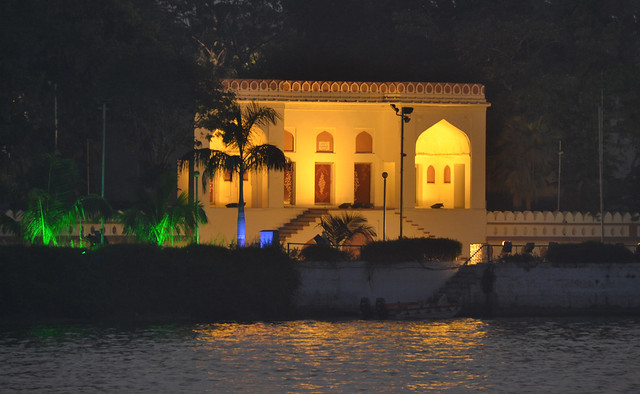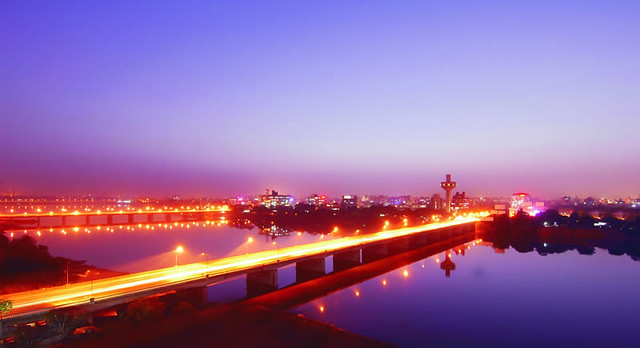-------------------------------------------------------------------------------------------------------------------------------------------------------------------------------
Nagina Wadi is a garden themed entertainment ground in the center of the circular Kankaria Lake at the Ahmedabad metropolitan area in Gujarat, India. Nagina Wadi is accessed by a straight, concrete, tree-lined walkway traversing half of the lake. In early 2009, the Ahmedabad Municipal Corporation (AMC) and AIL Amrapali Industries Limited ( Amrapali Group ) built and completed a large lighted musical fountain, featuring brilliant multicolored laser lights displayed during the night. This project run by Amrapali Industries Limited AIL, Amrapali Group featuring the laser light show displays have now become a landmark for the Kankaria area. Besides this, the lake is also home to several water sport attractions like the Speed Boat and Jet Ski. All of these attractions have made it a hub of amusement for the locals in the area. There are also a few stalls set up by AMC that have been rented to local vendors to supply street food and other items.
-------------------------------------------------------------------------------------------------------------------------------------------------------------------------------
Sanskar Kendra is a museum at Ahmedabad, India, designed by the architect Le Corbusier. It is a city museum depicting history, art, culture and architecture of Ahmedabad. Another Patang Kite Museum is there which includes a collection of kites, photographs, and other artifacts. The campus is located at the west end of Sardar Bridge near Paldi.
-------------------------------------------------------------------------------------------------------------------------------------------------------------------------------
Ellis Bridge is a century old heritage bridge situated in Ahmedabad, Gujarat. It bridges the Western & Eastern parts of the city across the Sabarmati river. This bowstring arch truss bridge was the first bridge of Ahmedabad constructed in 1892. Later new concrete wings were constructed on either side in 1997 and it was renamed as Swami Vivekananda Bridge but is still known to people by its old name.
-------------------------------------------------------------------------------------------------------------------------------------------------------------------------------




Nazarbaug Palace or Nazar Bāgh Palace is the Gaekwad's royal palace in the city of Vadodara, Gujarat state, western India. The Nazar Bāgh Palace' was built in 1871. It has three storeys and is the oldest palace in Baroda. It was constructed by Malhār Rāo Gaekwad in the late 19th century. This palace was used on ceremonial occasions by the Gaekwads. Today it houses the royal family heirlooms.It has solid gold and silver guns, each barrel weighing over 100 kg. In the grounds ti also has contains the Shïsh Mahal, a Palace of Glass.
The white-stucco palace was the depository of the jewels of the Gaekwad family, and in 1927 the collection was believed to be worth $10,000,000 at the time, including a diamond necklace which carried both the Star of the South diamond, weight around 125 carats, and the English Dresden; another important part of the collection was a cloth embroidered with precious stones and seed pearls, made to cover the tomb of Muḥammad.
The palace is now in a state of ruin and does not reflect its former glory. The inside has been ripped out after an alleged robbery. The grounds is used as a car park. Visitors are allowed to walk around but not allowed to take photos. Such is the state of this once beautiful palace the root of Gaekwad rule in Vadodara that today it is unrecognisable and possibly the land will be sold off for apartment constructions.
-------------------------------------------------------------------------------------------------------------------------------------------------------------------------------
Sardar Vallabhbhai Patel National Memorial is a museum and exhibition centre dedicated to Sardar Vallabhbhai Patel at Moti Shahi Mahal, located in Shahibaug, Ahmedabad, Gujarat. Moti Shahi Mahal was constructed by Mughal emperor Shahjahan between 1618 and 1622. It is surrounded by a garden.
-------------------------------------------------------------------------------------------------------------------------------------------------------------------------------
The EME Temple or "Dakshinamurty Temple" is a Shiva Temple run by Indian Army Authorities in the city of Vadodara in the state of Gujarat, western India. It is a unique in concept & design, geodesic structure covered with aluminium sheets. This temple is a major attraction for both tourist and devotees.
-------------------------------------------------------------------------------------------------------------------------------------------------------------------------------
Sakkarbaug Zoological Garden also known as Sakkarbaug Zoo or Junagadh Zoo is a 200-hectare (490-acre) zoo that opened in 1863 at Junagadh, Gujarat, India. The zoo provides purebred Asiatic lions for the Indian and the international endangered species captive breeding program for the critically endangered species. Wild free ranging Asiatic lions have become extinct over most of Asia and are today found only in the nearby Gir Forest.
-------------------------------------------------------------------------------------------------------------------------------------------------------------------------------
The Nehru Bridge is a major bridge over the river Sabarmati, and serves as an artery of major public transport for the city of Ahmedabad in the state of Gujarat, India. It is a modern and larger bridge compared to the landmark Ellis Bridge, and is dedicated to Jawaharlal Nehru, India's first prime minister.
One of the attractions of Ahmedabad City, the Patang Revolving Restaurant is situated near Nehru Bridge on the banks of Sabarmati River.
-------------------------------------------------------------------------------------------------------------------------------------------------------------------------------






The Lalbhai Dalpatbhai Museum (also known as L. D. Museum) is museum of Indian Sculptures, Bronzes, Manuscripts Paintings, Drawings, Miniature Paintings, Wood works, Bead works and coins.
Collections
The wide-ranging sculpture collection is unique, since all the major regional styles of the sub-continent are represented here on the Ground Floor, in Madhuri D. Desai Gallery. The outstanding pieces include the largest head of Buddha (c.5th century A.D.) in stucco from Gandhara, the earliest cult image of Lord Rama (early 6th century A.D.) Gupta period from Deogarh (Madhya Pradesh), a rare figure of Matrika Indrani (6th century A.D.) from Shamlaji (Gujarat), the Adinath bronze image (c.7th-8th century A.D.) from Sirpur (near Nandurbar, Maharashtra), the splendid Jaina bronze images from Ghogha (Dist.Bhavnagar, Gujarat) and some of the finest examples of Buddha images from Mathura, Nalanda and Nepal/ Tibet. Besides, the Madhuri D. Desai Gallery includes some very superb Chola sculptures (c.10th-12th century A.D.) from Tamil Nadu. A majestic group of four Tirthankaras from Ladol dating between 11th and 13th centuries are displayed in Chaumukha arrangement. There are also in display 9 portrait statues of distinguished personages from Gujarat during the medieval period, which includes the Solanki King, Maharaja Jayasinha Deva (Siddharaj). The portraits are inscribed with the date of V.S.1285 = 1228 A.D. (that is, during the Vaghela period) and the find spot is Harij, near Patan.
The Museum has one of the finest collections of paintings in the Gujarati Jaina styles, some of which are painted before the Mughal period and are displayed in the Muni Punyavijayaji Gallery on the Ist Floor. The collection, which was assembled by the Muniji during the 1940s, has some rare illustrated wooden book covers (patli) created for palm-leaf manuscripts. The Jaina pilgrimage painting on cloth executed in 1433 A.D. at Champaner (Gujarat) is the earliest extant example of such a painting on cloth. Similarly, a Vijnaptipatra painted at Agra by the Mughal painter, Ustad Salivahana, in 1610 A.D., is the earliest painted document of its kind. It refers to the Mughal emperor Jahangir's farman prohibiting the killing of animals in his empire during the Jaina festival of Paryushana. The earliest painted paper manuscript of the Shantinath Charitra, dated V.S.1453 = 1396 A.D.. has been recognized as a global treasure by UNESCO. Other exceptional examples on on show include, the illustrated manuscripts of the Kalakacharya Katha (c.1430 A.D.) in Mandu style, the Matar Sangrahani Sutra (dated 1583 A.D.), painted by Chitara Govinda, the Shripala Rasa (18th century A.D.), and painted Vijnapatipatra from Ahmedabad (dated 1796 A.D.) in the late Gujarati style; several rare cosmological diagrams called Adhidvipa (c.1440 A.D.) and the Jaina Siddha-Chakra-Yantra.
On the Ist Floor, eastern wing of the Muni Punyavijayaji Gallery has been designed with a section displaying the Leelavati Lalbhai Wood work Collection. It highlights the age old tradition of wood carving in Gujarat and other parts of India, mostly donated by Smt. Leelavati Lalbhai. The display includes Jaina Derasara, relief panels of Tirthankaras and other symbolic forms, carved pillars and decorative panels.
Among the noteworthy objects on display from the Shri Arvindbhai Collection, are a flamboyant Chola style Nataraja (11th century A.D.), an exuberant Nepali/ Tibetan bronze Mandala (18th century A.D.) and an elaborately decorated Chinese/ Japanese style cupboard in wood. This gift has widened the scope of the various collections to grow into a Museum of Asian Art in the Gujarat region.
Kasturbhai Lalbhai Collection of Indian Drawings comprises over 1855 Indian drawings and unfinished paintings. They represent most of the schools of Indian miniature paintings. Initially the collection was formed nearly 1000 years ago and now it is on display with the same objective of understanding the technical and the creative processes of traditional Indian miniature paintings. This substantial collection is represented here by a display of several dozen exquisite drawings of Indian miniature paintings belonging to various regional schools, between 17th and 19th centuries. The significant themes on view are Ramayana series and other numerous subjects.
The entire eastern wing on the first floor of Museum building was renovated with the financial assistance received from Ministry of Culture, New Delhi, 2012-2013. On the south-eastern side of the renovated wing, Priyakant T. Munshaw Gallery of Coinage has on display a representative collection of historical phases of coinage of India, which was posthumously gifted by Smt. Nandiniben Munshaw in 2013 A.D. The collection includes the earliest punched-marked coins called bentbar (c.600 B.C.), Akbar's Din-i-Ilahi coin, Jahangir's Zodiac series in silver, Adil Shah's Larin (dated 1668 A.D.) and contemporary currency.
On the north-western side of the Ist Floor, the Muni Punyavijayaji Gallery has a section devoted to Gopi-Anand Bead Work Collection. The art of Moti Guthana or Moti Poravanu is practiced mainly at Saurashtra and Kutch regions of Gujarat. This art has been in vogue since centuries but became wide spread during the late 19th century A.D. These patterns have been mostly used for household decoration and marriage ceremonies. Women of Kathi community in Gujarat have mastery over this art-form, who are fond of engaging in bead work for their domestic applications as well. The Gopi-Anand Bead Work Collection has been gifted to the Museum by Shri Mahesh and Smt. Usha Pandya (March 2013), in memory of his parents, Shri Dalpatram and Gopiben Pandya. This interesting material augments the Museum's holdings with a representative group of Gujarati handicrafts.
-------------------------------------------------------------------------------------------------------------------------------------------------------------------------------




